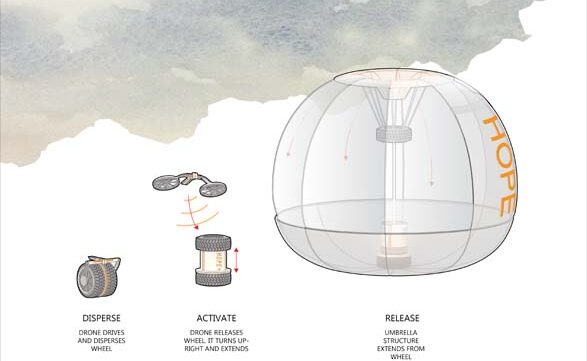Blog
Breaking Through 2020 Finalist HDR Presents Bubbles of Hope

One of the four finalists in Healthcare Design’s 2020 Breaking Through competition is Bubbles of Hope, submitted by HDR. Check out the video presentation given live during the HCD Virtual event.
Breaking Through 2020 Finalist: Bubbles of Hope
The post information below was originally seen here, by Jennifer Kovacs Silvis, editor-in-chief | December 1, 2020
Images and Video Courtesy of HDR
Images and Video Courtesy of HDR
BREAKING THROUGH 2020 FINALIST
Concept: Bubbles of Hope
Firm: HDR
Team representatives: Alex Chen, architectural designer; Chris DePalma, project architect;
Insung Hwang, architectural designer; Paul Daniel, lighting designer; and Ying Luo, architectural intern
The challenge: When earthquakes, floods, and pandemics occur, they result in displacement, injuries, and death in addition to pressure on local health systems and first responders. Often, targeted responses are hindered by a lack of accessibility and/or spatial constraints. Additionally, shelters constructed for those displaced are often uncomfortable and stressful for occupants, and strategic responses typically require both victims and first responders to be in the same location.
The concept: Bubbles of Hope envisions deployable homes, or simple, temporary structures that provide safety and comfort in a flexible, adaptable form. It reimagines the disaster response process, too, by innovating typical solutions for both the shelter and field hospital. For example, field hospitals generally put caregivers in dangerous situations; but with technology available today, care could be distributed remotely via drone. The shelter itself is reconfigured into a spherical form that offers a space to triage and serve as a short-term home.
The details: The bubbles themselves are made of a lightweight steel structure that unfolds from a small wheel capsule delivered to disaster sites by drone. After unfolding, the tent-like structure locks together magnetically and is constructed of a durable, waterproof, self-repairing fabric. Artificial intelligence directs inhabitants on performing triage and first aid via an interactive screen, while the central core holds water and food. The entire form is powered by photovoltaics on top of the bubble that generate electricity to supplement an integrated power pack. Bubbles of Hope are color coded to denote availability: green being available, yellow partially occupied, and red full.
The bubbles are designed to be scattered in an earthquake, with fabric malleable to accommodate rough terrain. In the case of flooding, the units can aggregate to help stabilize them and avoid being washed away, while interior filtration allows use of outside water. In a pandemic scenario, the bubbles might be used for isolation or supply distribution or as a haven for the homeless to quarantine. Disaster management takes place remotely, with drones remaining over disaster zones to provide two-way communication with the control center.
Marie Wikoff is the creator of Wikoff Design Studio based out of Reno, Nevada. Her expertise in healthcare design has helped modernize healthcare organizations locally, regionally, and internationally, improving patient experience and outcomes. Her credentials include Evidence-Based Design Accreditation and Certification (EDAC), American Academy of Healthcare Interior Designer (CHID), the National Council of Interior Design Qualification (NCIDQ) and LEED AP. Contact Marie Wikoff







